From Black to White: A Hillbilly Version of Gussie L. Davis's "The Fatal Wedding" by William Kearns
The Black Perspective in Music, Vol. 2, No. 1 (Spring, 1974), pp. 29-36
FROM BLACK TO WHITE: A HILLBILLY VERSION OF GUSSIE L. DAVIS'S "THE FATAL WEDDING" By WILLIAM KEARNS
The music of black composers can sometimes turn up in unexpected places. Such is the case with "The Fatal Wedding" (1893) of Gussie L. Davis, one of the better known black singers and composers at the turn of the century. [1] His even more famous "The Baggage Coach Ahead" (1896) sold more than a million copies of sheet music; [2] however, "The Fatal Wedding" was sufficiently popular to have a wide dissemination and even mawkish imitations.[3]
A version of "The Fatal Wedding" was recorded in 1927 by Ernest Stoneman, one of the important performers in the so-called golden age of the hillbilly tradition.[4] Although the repertory of other hillbilly performers of that time, such as Sam and Kirk McGee, shows blues and jazz influence and thus clearly establishes a relationship between black and hillbilly musical cultures, Stoneman's use of Davis's tune [5] demonstrates yet another connection-that of a sentimental, popular song from the 19th century which entered the aural tradition and, although it gradually faded away in urban culture, persisted in the rural areas. [6] It thus became the sort of old favorite among the folk that an enterprising commercial hillbilly performer such as Stoneman would choose to record.
A comparison of the original lyrics and Stoneman's rendition shows that W. H. Windom's verses remain essentially the same in both versions. The tune, however, has undergone a decided change from a rather expansive, chromatically-tinctured melody supported by a fairly elaborate harmonic scheme to a ditty of folklike simplicity, devoid of chromatic ornamentation and retaining only the most essential harmonic underpinning. Davis's song (Example 1) can be divided into three parts of four phrases each. The first and middle sections are settings for two stanzas of verse, and the last part serves as a refrain. Thus two repetitions of the song serve the entire story. Davis achieved an archlike structure among his three sections largely through harmonic action. This construction is the most striking feature of the piece. The first section (meas. 1-32) is self-contained, consisting of antecedent-consequent period structure and a concluding cadence on the tonic G. The middle section begins in the mediant minor (meas. 33-40) and pushes on to the dominant (meas. 41-48) before returning to G major with the identical two phrases that close the first section. The refrain or section introduces closing some rhythmic variation with the Scotch-snap figure (meas. 68, 76, 84) and stays closer than the middle section to the primary chord progressions of the tonic G. The refrain is not without its moments of harmonic tension, however, in the rise to a dominant-level cadence at the conclusion of the second phrase (meas. 77-80) and the transient V-I action at the supertonic level suggested in the first half of the last phrase (meas. 89-92).
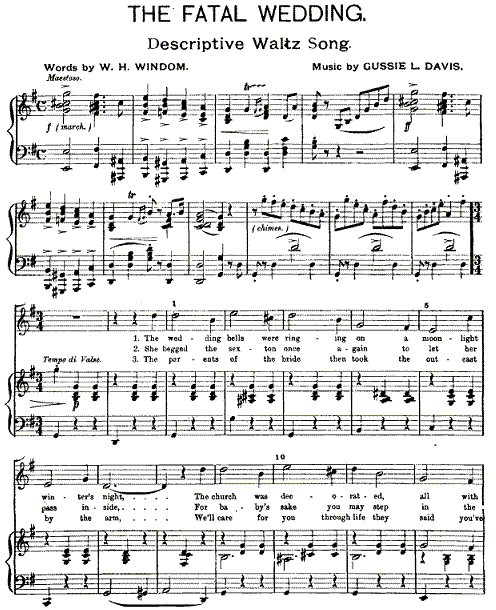
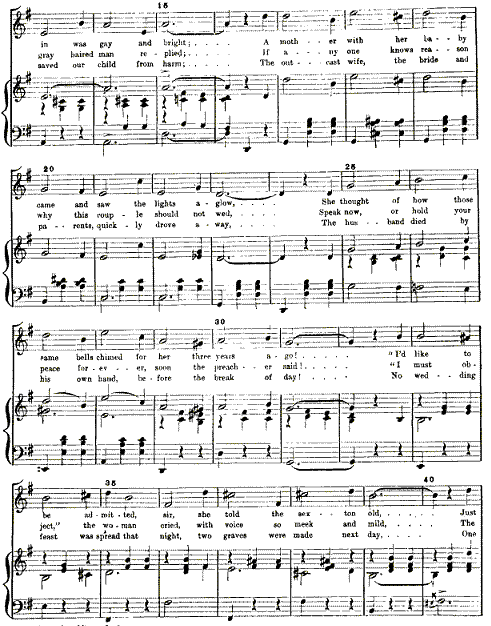
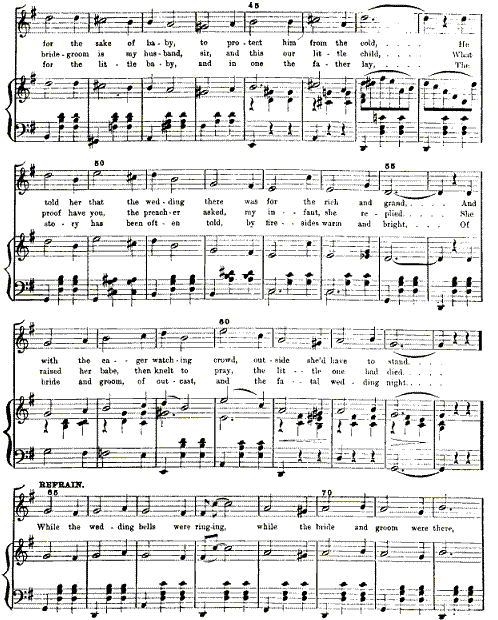
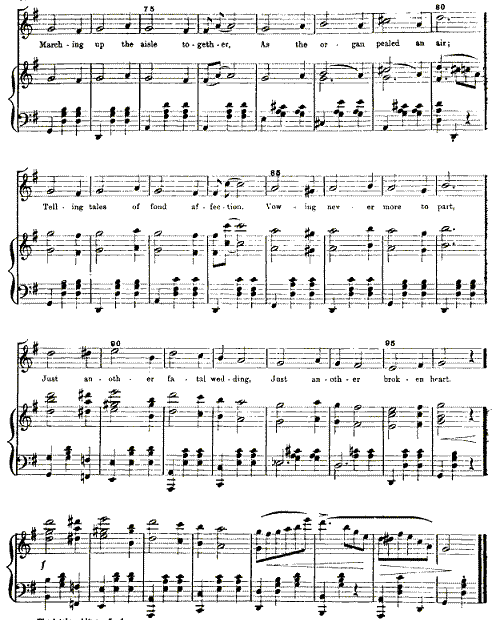
Stoneman's version (Example 2) is vastly simpler in several ways. Gone are the chromatic embellishments of the melody, which itself has been reduced to the first four phrases or first section of Davis's song. With a ballad singer's emphasis on the unfolding of the story,[7] Stoneman incorporated the refrain as the second stanza and thereafter proceeded from verse to verse without any refrain repetition. Thus the first section of Davis's melody became the basis of a simple, four-phrase, strophic song, seven stanzas in length.
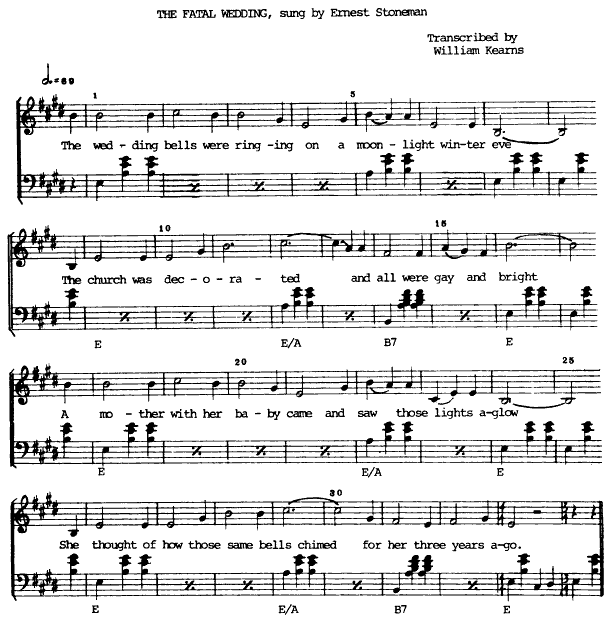
The original elaborate accompaniment, which includes a maestoso introduction consisting of the opening strains of Mendelssohn's Wedding March, followed by an imitation of chimes, is now reduced to a guitar outlining the three-four meter with a repetitive pattern of bass note followed by chordal afterbeats. Likewise, the harmonic action so essential to the structural unity of the original song is now greatly lessened. A suggestion of subdominant harmony in the bass line (meas. 5-6; 22-23) is contradicted by the prevailing E-major afterbeats carried over from the previous tonic harmony. The only effective harmonic progression is the move to the dominant and return to tonic harmony at the two principal cadence points of the song (meas. 14-17; 31-33). Thus harmony, which is a principal component for Davis's song, is quite subordinate in Stoneman's version, serving largely as an E-major triadic coloring for the melody.
As one might expect from a performer close to the folk tradition, Stoneman relaxed the rigid symmetry of Davis's eight-bar phrasing. Thus the second and fourth phrases each have an additional measure as Stoneman dwelled on the top pitch, c: (meas. 12, 29). Another asymmetrical touch is the diminutive bass run (meas. 33-34; C to e) which divides each stanza of the story.
Stoneman's version of "The Fatal Wedding" is thus a good illustration of adaptation to traditional ballad style, with the melody hewed down to its most essential form and used in a supporting role to the ballad verse itself. Davis's original tune must be regarded not only as a popular melody of the nineties but, in addition, as a source for a folk-like song extending well into the 20th century.
The Fatal Wedding (Lyrics)
The wedding bells were ringing on a moonlight winter eve,
The church was decorated and all were gay and bright.
A mother with her baby came and saw those lights aglow;
She thought of how those same bells chimed for her three years ago.
The wedding bells were ringing and the bride and groom were there;
Marching up the aisle together as the organ played an air.
A telling tales of fond affecting by never more to part;
Just another fatal wedding bell, another broken heart.
"I'd like to be admitted, sir," she begged the sexton old;
"Just for the sake of baby to protect him from the cold;"
But he told her that the wedding there was for the rich and grand;
And with an eager watching crowd, outside she'd have to stand.
She begged the sexton once again to let herself inside;
"For baby's sake you may come in," the gray-haired man replied.
"If anyone here knows a reason why this couple should not wed;
Speak now or else forever hold your peace," the preacher said.
"I must object," the woman cried, her voice was meek and mild;
"The bridegroom is my husband, sir, and this our little child."
"What proof have you," the preacher said, "My baby, sir," she replied;
She knelt and prayed to God in heaven, for the little one had died.
The parents of the bride then took the outcast by the arm;
"We'll care for you through life," they said, "you saved our child from harm."
The parents, bride, and the outcast was in the carriage rolled away;
The bridegroom died by his own hand before the break of day.
No wedding feast was spread that night, two graves were made next day;
In one a little baby slept, in one a father lay.
This story has been often told by the fireside warm and bright;
Of the parents, bride, and the outcast wife on a fatal wedding night.
NOTES
1. Julius Mattfield, Variety Music Cavalcade (Englewood Cliffs, N. J.: Prentice-Hall, Inc., 3rd ed., 1971), p. 208.
2. Eileen Southern, The Music of Black Americans: A History (New York: W. W. Norton and Co., 1971), p. 270.
3. "Those Wedding Bells Shall Not Ring Out" (1896), by Monroe H. Rosenfeld, is such an imitation. See Robert A. Freemont, ed., Favorite Songs of the Nineties (New York: Dover Publications, Inc., 1973), p. 315.
4. Norman Cohen et al., The Early Recording Career of Ernest "Pop" Stoneman: A Bio-Discography (Los Angeles: The John Edwards Memorial Foundation Special Series, No. 1, Folklore and Mythology Center, U. C. L. A., 1968), p. 10. Two recordings of "The Fatal Wedding" are listed here-one by OKEH, made on Jan. 29, 1927; the other by Edison, on May 10, 1927. I have transcribed the latter (Matrix No. 11693-c/?; release no. Ed 52026) from the University of Colorado collection of folk and folk-related recordings as Example 2.
5. Sigmund Spaeth's Read 'Em and Weep (New York: Halycon House Edition, 1939), pp. 171-172, has the melody and verses of the original, published tune.
6. See Vance Randolph, Ozark Folksongs, 4 vols. (Columbia, Missouri: The State Historical Society of Missouri, 1946-50), vol. 4, pp. 277-79, for an example and listing of other sources.
7. G. Malcolm Laws, Jr., in his Native American Balladry (Philadelphia: American Folklore Society, Biographical and Special Series, 1964), vol. 1, rev., p. 277, excludes "The Fatal Wedding" from balladry proper because it is a "melodramatic and sentimental piece . . . of professional origin." He does, however, grant it the classification, "ballad-like."